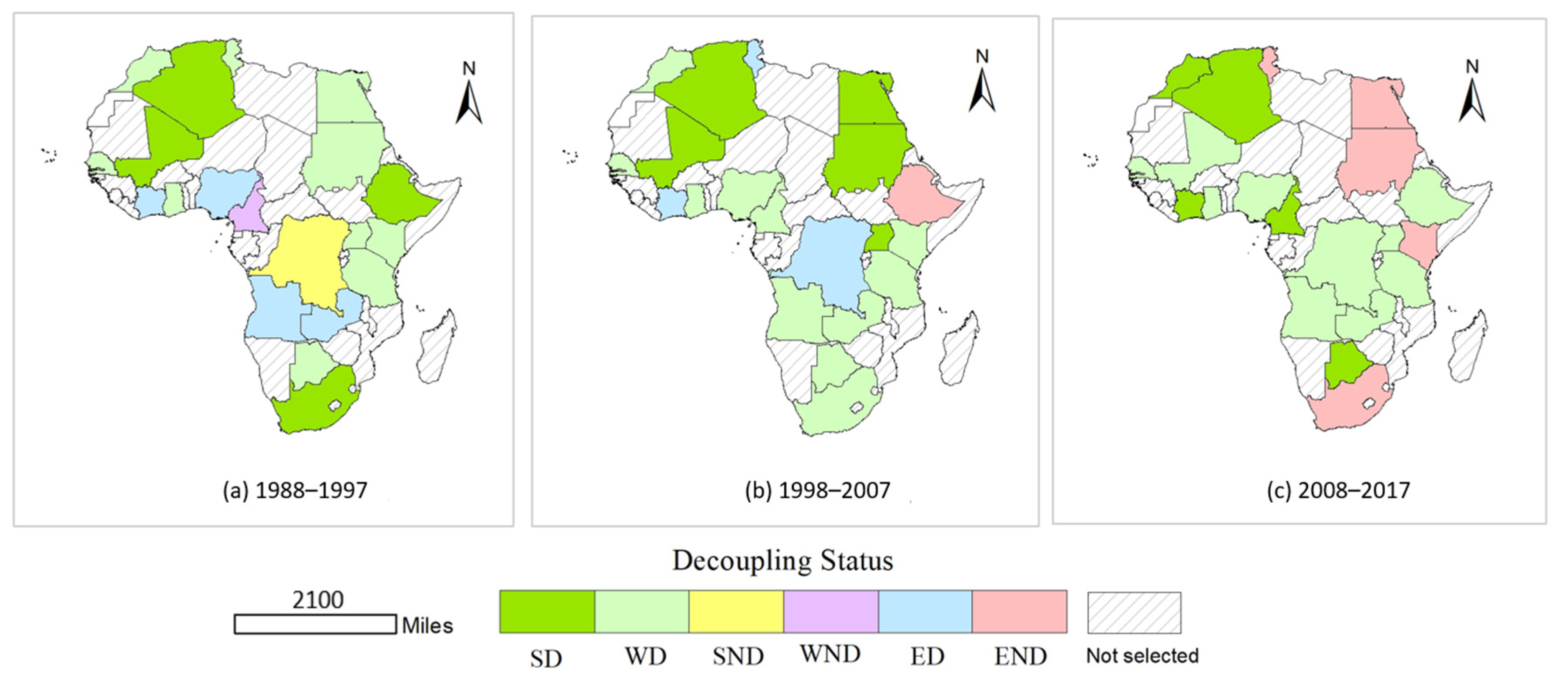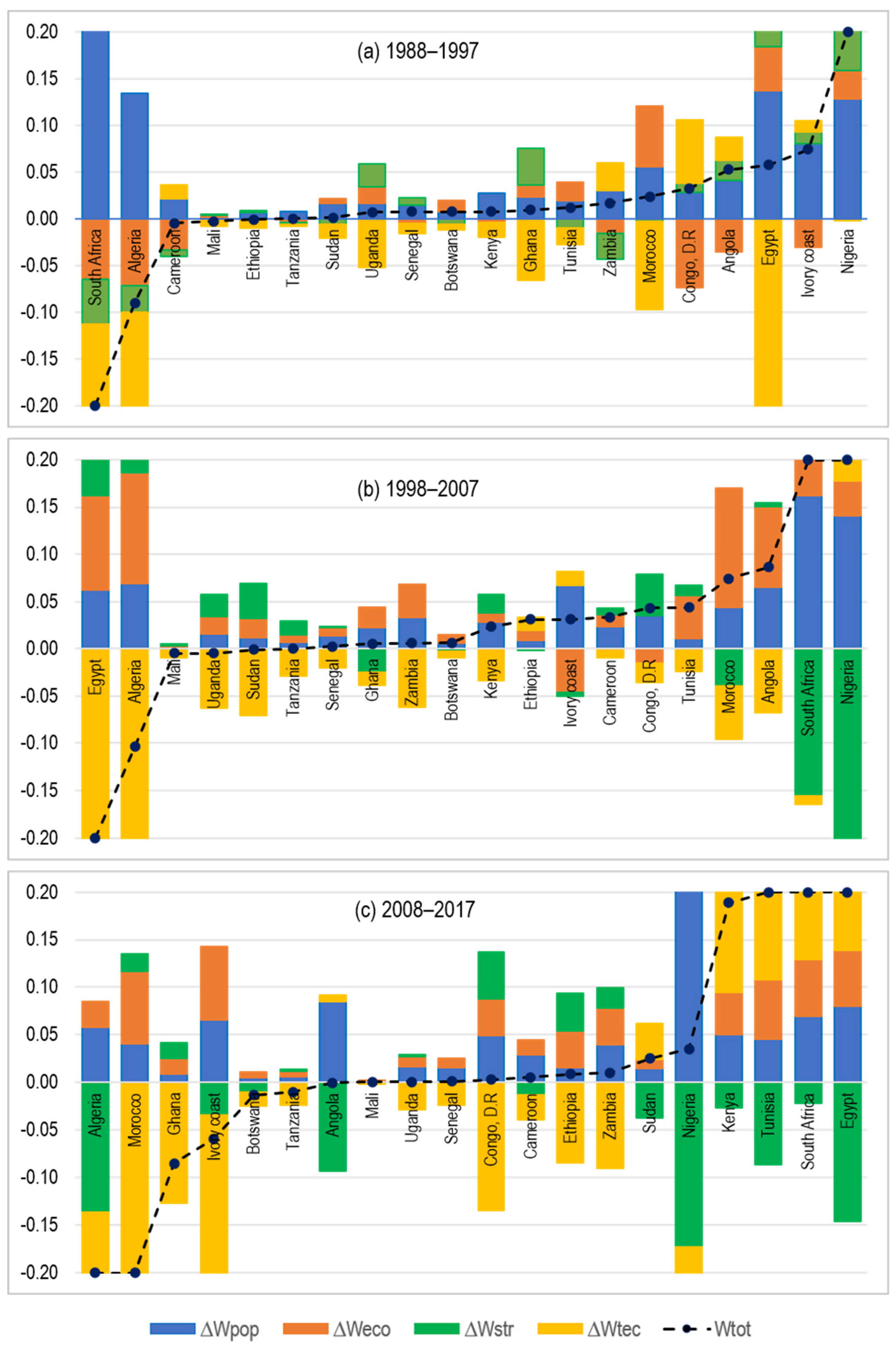A Spatio-Temporal Assessment of Industrial Water Use in African Countries
Abstract
1. Introduction
2. Methods
2.1. Data Sources
2.2. Decoupling Analysis
2.3. Cluster Analysis
2.4. Decomposition Analysis
3. Results
3.1. Spatial Distribution of Industrial Water Withdrawal
3.2. Hierarchical Cluster Analysis of Industrial Water Use and GDP
3.3. Decoupling of Water Use from Economic Growth
3.4. Decomposition Analysis of Industrial Water Withdrawal
4. Discussion
5. Conclusions
Author Contributions
Funding
Data Availability Statement
Conflicts of Interest
References
- Haddeland, I.; Heinke, J.; Biemans, H.; Eisner, S.; Flörke, M.; Hanasaki, N.; Konzmann, M.; Ludwig, F.; Masaki, Y.; Schewe, J. Global water resources affected by human interventions and climate change. Proc. Natl. Acad. Sci. USA 2014, 111, 3251–3256. [Google Scholar] [CrossRef]
- Zhang, C.; Xu, J.; Chiu, Y.-H. Driving factors of water use change based on production and domestic dimensions in Jiangsu, China. Environ. Sci. Pollut. Res. 2020, 27, 33351–33361. [Google Scholar] [CrossRef]
- Veldkamp, T.; Wada, Y.; Aerts, J.; Döll, P.; Gosling, S.N.; Liu, J.; Masaki, Y.; Oki, T.; Ostberg, S.; Pokhrel, Y. Water scarcity hotspots travel downstream due to human interventions in the 20th and 21st century. Nat. Commun. 2017, 8, 15697. [Google Scholar] [CrossRef] [PubMed]
- Wada, Y.; Flörke, M.; Hanasaki, N.; Eisner, S.; Fischer, G.; Tramberend, S.; Satoh, Y.; van Vliet, M.T.H.; Yillia, P.; Ringler, C.; et al. Modeling global water use for the 21st century: The Water Futures and Solutions (WFaS) initiative and its approaches. Geosci. Model Dev. 2016, 9, 175–222. [Google Scholar] [CrossRef]
- Schewe, J.; Heinke, J.; Gerten, D.; Haddeland, I.; Arnell, N.W.; Clark, D.B.; Dankers, R.; Eisner, S.; Fekete, B.M.; Colón-González, F.J. Multimodel assessment of water scarcity under climate change. Proc. Natl. Acad. Sci. USA 2014, 111, 3245–3250. [Google Scholar] [CrossRef] [PubMed]
- Food and Agriculture Organization of the United Nations (FAO). AQUASTAT MainDatabase. 2016. Available online: http://www.fao.org/nr/water/aquastat/tables/WorldData-Withdrawal_eng.pdf (accessed on 10 September 2022).
- Fujimori, S.; Hanasaki, N.; Masui, T. Projections of industrial water withdrawal under shared socioeconomic pathways and climate mitigation scenarios. Sustain. Sci. 2017, 12, 275–292. [Google Scholar] [CrossRef]
- Signé, L. The Potential of Manufacturing and Industrialization in Africa: Trends, Opportunities, and Strategies; Brookings: Washington, DC, USA, 2018. [Google Scholar]
- Coulibaly, B.S. Foresight Africa: Top priorities for the continent 2020 to 2030; Africa Growth Initiative; Brookings: Washington, DC, USA, 2020. [Google Scholar]
- Busby, J.W.; Smith, T.G.; White, K.L.; Strange, S.M. Locating climate insecurity: Where are the most vulnerable places in Africa? In Climate Change, Human Security and Violent Conflict; Springer: Berlin/Heidelberg, Germany, 2012; pp. 463–511. [Google Scholar]
- Adu, D.T.; Denkyirah, E.K. Economic Growth and Environmental Pollution in West Africa: Testing the Environmental Kuznets Curve Hypothesis. Kasetsart J. Soc. Sci. 2018, 40, 281–288. Available online: https://so04.tci-thaijo.org/index.php/kjss/article/view/242142 (accessed on 3 March 2024). [CrossRef]
- Flörke, M.; Kynast, E.; Bärlund, I.; Eisner, S.; Wimmer, F.; Alcamo, J. Domestic and industrial water uses of the past 60 years as a mirror of socio-economic development: A global simulation study. Glob. Environ. Change 2013, 23, 144–156. [Google Scholar] [CrossRef]
- Willet, J.; Wetser, K.; Vreeburg, J.; Rijnaarts, H. Industry. Review of methods to assess sustainability of industrial water use. Water Resour. Ind. 2019, 21, 100110. [Google Scholar] [CrossRef]
- Weizsäcker, E.U.v. Erdpolitik: Ökologische Realpolitik an der Schwelle zum Jahrhundert der Umwelt; Büchergilde Gutenberg: Frankfurt am Main, Germany, 1990. [Google Scholar]
- Wang, X.; Li, R. Is urban economic output decoupling from water use in developing countries?—Empirical analysis of Beijing and Shanghai, China. Water 2019, 11, 1335. [Google Scholar] [CrossRef]
- Organisation for Economic Co-operation and Development. OECD Environmental Strategy for the First Decade of the 21st Century: Adopted by OECD Environmental Ministers; OECD: Paris, France, 2001. [Google Scholar]
- Tapio, P. Towards a theory of decoupling: Degrees of decoupling in the EU and the case of road traffic in Finland between 1970 and 2001. Transp. Policy 2005, 12, 137–151. [Google Scholar] [CrossRef]
- Shuai, C.; Chen, X.; Wu, Y.; Zhang, Y.; Tan, Y. A three-step strategy for decoupling economic growth from carbon emission: Empirical evidences from 133 countries. Sci. Total Environ. 2019, 646, 524–543. [Google Scholar] [CrossRef] [PubMed]
- Wu, Y.; Chau, K.; Lu, W.; Shen, L.; Shuai, C.; Chen, J. Decoupling relationship between economic output and carbon emission in the Chinese construction industry. Environ. Impact Assess. Rev. 2018, 71, 60–69. [Google Scholar] [CrossRef]
- Li, Y.; Luo, Y.; Wang, Y.; Wang, L.; Shen, M. Decomposing the decoupling of water consumption and economic growth in China’s textile industry. Sustainability 2017, 9, 412. [Google Scholar] [CrossRef]
- Xing, Z.; Wang, J.; Feng, K.; Hubacek, K.J. Decomposition and attribution analysis for assessing the progress in decoupling industrial development from wastewater discharge in China. J. Clean. Prod. 2020, 266, 121789. [Google Scholar] [CrossRef]
- Zhang, Y.; Liu, W.; Cai, Y.; Khan, S.U.; Zhao, M. Decoupling analysis of water use and economic development in arid region of China–based on quantity and quality of water use. Sci. Total Environ. 2021, 761, 143275. [Google Scholar] [CrossRef]
- Wang, Q.; Jiang, R.; Li, R. Decoupling analysis of economic growth from water use in City: A case study of Beijing, Shanghai, and Guangzhou of China. Sustain. Cities 2018, 41, 86–94. [Google Scholar] [CrossRef]
- Ang, B.W. Decomposition analysis for policymaking in energy:: Which is the preferred method? Energy Policy 2004, 32, 1131–1139. [Google Scholar] [CrossRef]
- Yang, H.; Zehnder, A. “Virtual water”: An unfolding concept in integrated water resources management. Water Resour. Res. 2007, 43, W12301. [Google Scholar] [CrossRef]
- Shang, Y.; Lu, S.; Li, X.; Sun, G.; Shang, L.; Shi, H.; Lei, X.; Ye, Y.; Sang, X.; Wang, H. Drivers of industrial water use during 2003–2012 in Tianjin, China: A structural decomposition analysis. J. Clean. Prod. 2017, 140, 1136–1147. [Google Scholar] [CrossRef]
- Wang, Q.; Wang, X. Moving to economic growth without water demand growth—A decomposition analysis of decoupling from economic growth and water use in 31 provinces of China. Sci. Total Environ. 2020, 726, 138362. [Google Scholar] [CrossRef]
- Ma, B.; Tian, G.; Kong, L.; Research, P. Spatial-temporal characteristics of China’s industrial wastewater discharge at different scales. Environ. Sci. Pollut. Res. 2020, 27, 8103–8118. [Google Scholar] [CrossRef] [PubMed]
- Yang, J.; Chen, X. Quantification of the driving factors of water use in the productive sector change using various decomposition methods. Water Resour. Manag. 2019, 33, 4105–4121. [Google Scholar] [CrossRef]
- Shang, Y.; Wang, J.; Ye, Y.; Lei, X.; Gong, J.; Shi, H. An analysis of the factors that influence industrial water use in Tianjin, China. Int. J. Water Resour. Dev. 2017, 33, 81–92. [Google Scholar] [CrossRef]
- Zhang, C.; Zhong, L.; Wang, J. Decoupling between water use and thermoelectric power generation growth in China. Nat. Energy 2018, 3, 792–799. [Google Scholar] [CrossRef]
- Jia, C.; Yan, P.; Liu, P.; Li, Z.J.R.; Reviews, S.E. Energy industrial water withdrawal under different energy development scenarios: A multi-regional approach and a case study of China. Sustain. Energy Rev. 2021, 135, 110224. [Google Scholar] [CrossRef]
- Avelino, A.F.T.; Dall’erba, S. What Factors Drive the Changes in Water Withdrawals in the US Agriculture and Food Manufacturing Industries between 1995 and 2010? Environ. Sci. Technol. 2020, 54, 10421–10434. [Google Scholar] [CrossRef]
- Engo, J.; Research, P. Driving forces and decoupling indicators for carbon emissions from the industrial sector in Egypt, Morocco, Algeria, and Tunisia. Environ. Sci. Pollut. Res. 2021, 28, 14329–14342. [Google Scholar] [CrossRef]
- Simbi, C.H.; Lin, J.; Yang, D.; Ndayishimiye, J.C.; Liu, Y.; Li, H.; Xu, L.; Ma, W. Decomposition and decoupling analysis of carbon dioxide emissions in African countries during 1984–2014. J. Environ. Sci. 2021, 102, 85–98. [Google Scholar] [CrossRef]
- Achraf, A.; Boudhar, S.; Lechheb, H.; Ouakil, H. Sectoral water footprint dynamics: An input-output structural decomposition analysis for Morocco. E3S Web Conf. 2021, 234, 00041. [Google Scholar] [CrossRef]
- Zhou, F.; Bo, Y.; Ciais, P.; Dumas, P.; Tang, Q.; Wang, X.; Liu, J.; Zheng, C.; Polcher, J.; Yin, Z. Deceleration of China’s human water use and its key drivers. Proc. Natl. Acad. Sci. USA 2020, 117, 7702–7711. [Google Scholar] [CrossRef]
- Zhao, X.; Liu, J.; Liu, Q.; Tillotson, M.R.; Guan, D.; Hubacek, K. Physical and virtual water transfers for regional water stress alleviation in China. Proc. Natl. Acad. Sci. USA 2015, 112, 1031–1035. [Google Scholar] [CrossRef]
- FAO. AQUASTAT—FAO’s Global Information System on Water and Agriculture. 2019. Available online: http://www.fao.org/aquastat/en/ (accessed on 2 March 2024).
- World Bank. World Bank Development Indicators (WDI). National Accounts Data, and OECD National Accounts Data. Available online: https://databank.worldbank.org/source/world-development-indicators (accessed on 1 August 2023).
- Everitt, B.S.; Landau, S.; Leese, M.; Stahl, D. Cluster Analysis; Wiley: Hoboken, NJ, USA, 2011. [Google Scholar]
- Murtagh, F.; Legendre, P. Ward’s hierarchical agglomerative clustering method: Which algorithms implement Ward’s criterion? J. Classific. 2014, 31, 274–295. [Google Scholar] [CrossRef]
- Kacperska, E.; Łukasiewicz, K.; Pietrzak, P. Use of renewable energy sources in the European Union and the Visegrad Group countries—Results of cluster analysis. Energies 2021, 14, 5680. [Google Scholar] [CrossRef]
- Kaya, Y. Impact of carbon dioxide emission control on GNP growth: Interpretation of proposed scenarios. In Proceedings of the Intergovernmental Panel on Climate Change, Washington, DC, USA, 30 January–2 February1989. [Google Scholar]
- Zhang, T.; Wang, X.; Qi, G.; Shahid, S.; Kang, Y.; Wu, H.; Zhang, X. Analysis of the Decoupling State and Driving Effects of Economic Development and Production Water Use in Jiangsu Province, China. Sustainability 2023, 15, 10258. [Google Scholar] [CrossRef]
- Mendoza-Grimón, V.; Fernández-Vera, J.R.; Silva, G.D.; Semedo-Varela, A.; Palacios-Díaz, M.d.P. Cape Verde (West Africa) Successful Water Reuse Pilot Project: A Sustainable Way for Increasing Food Production in a Climate Change Scenario. Water 2021, 13, 160. [Google Scholar] [CrossRef]





| Region | Population (Million) | Population Growth (%) | Urbanization Rate (%) | Area (Million km2) | Selected Countries |
|---|---|---|---|---|---|
| Northern | 254.05 | 1.56 | 52.4 | 7.76 | Egypt, Tunisia, Morocco, Sudan, and Algeria |
| Eastern | 467.44 | 2.71 | 47.7 | 6.67 | Kenya, Ethiopia, Uganda, and Tanzania |
| Middle Africa | 189.56 | 3.10 | 50.5 | 6.50 | D.R. Congo, Angola, and Cameroon |
| Southern | 69.17 | 1.40 | 64.7 | 2.65 | South Africa, Botswana, and Zambia |
| Western | 421.56 | 2.70 | 47.7 | 6.06 | Senegal, Mali, Ivory Coast, Nigeria, and Ghana |
| Degree of Decoupling/Coupling | ΔW | ΔG | Δdi |
|---|---|---|---|
| Strong decoupling (SD) | <0 | >0 | <0 |
| Weak decoupling (WD) | >>0 | >>0 | >>0 |
| Expansive coupling (EC) | >0 | >0 | 0.8> >>0 |
| Expansive negative decoupling (END) | >0 | >0 | >1.2 |
| Strong negative decoupling (SND) | <0 | <0 | <0 |
| Weak negative decoupling (WND) | <0 | <0 | 0.8> >0 |
| Recessive coupling (RC) | <0 | <0 | 1.2> >0.8 |
| Recessive decoupling (RD) | <0 | <0 | >1 |
Disclaimer/Publisher’s Note: The statements, opinions and data contained in all publications are solely those of the individual author(s) and contributor(s) and not of MDPI and/or the editor(s). MDPI and/or the editor(s) disclaim responsibility for any injury to people or property resulting from any ideas, methods, instructions or products referred to in the content. |
© 2025 by the authors. Licensee MDPI, Basel, Switzerland. This article is an open access article distributed under the terms and conditions of the Creative Commons Attribution (CC BY) license (https://creativecommons.org/licenses/by/4.0/).
Share and Cite
Kipkirui, E.; Zhao, J.; Lu, S.; Mbuge, D.O.; Wang, T. A Spatio-Temporal Assessment of Industrial Water Use in African Countries. Water 2025, 17, 3313. https://doi.org/10.3390/w17223313
Kipkirui E, Zhao J, Lu S, Mbuge DO, Wang T. A Spatio-Temporal Assessment of Industrial Water Use in African Countries. Water. 2025; 17(22):3313. https://doi.org/10.3390/w17223313
Chicago/Turabian StyleKipkirui, Edwin, Jianfu Zhao, Sha Lu, Duncan Onyango Mbuge, and Tao Wang. 2025. "A Spatio-Temporal Assessment of Industrial Water Use in African Countries" Water 17, no. 22: 3313. https://doi.org/10.3390/w17223313
APA StyleKipkirui, E., Zhao, J., Lu, S., Mbuge, D. O., & Wang, T. (2025). A Spatio-Temporal Assessment of Industrial Water Use in African Countries. Water, 17(22), 3313. https://doi.org/10.3390/w17223313







